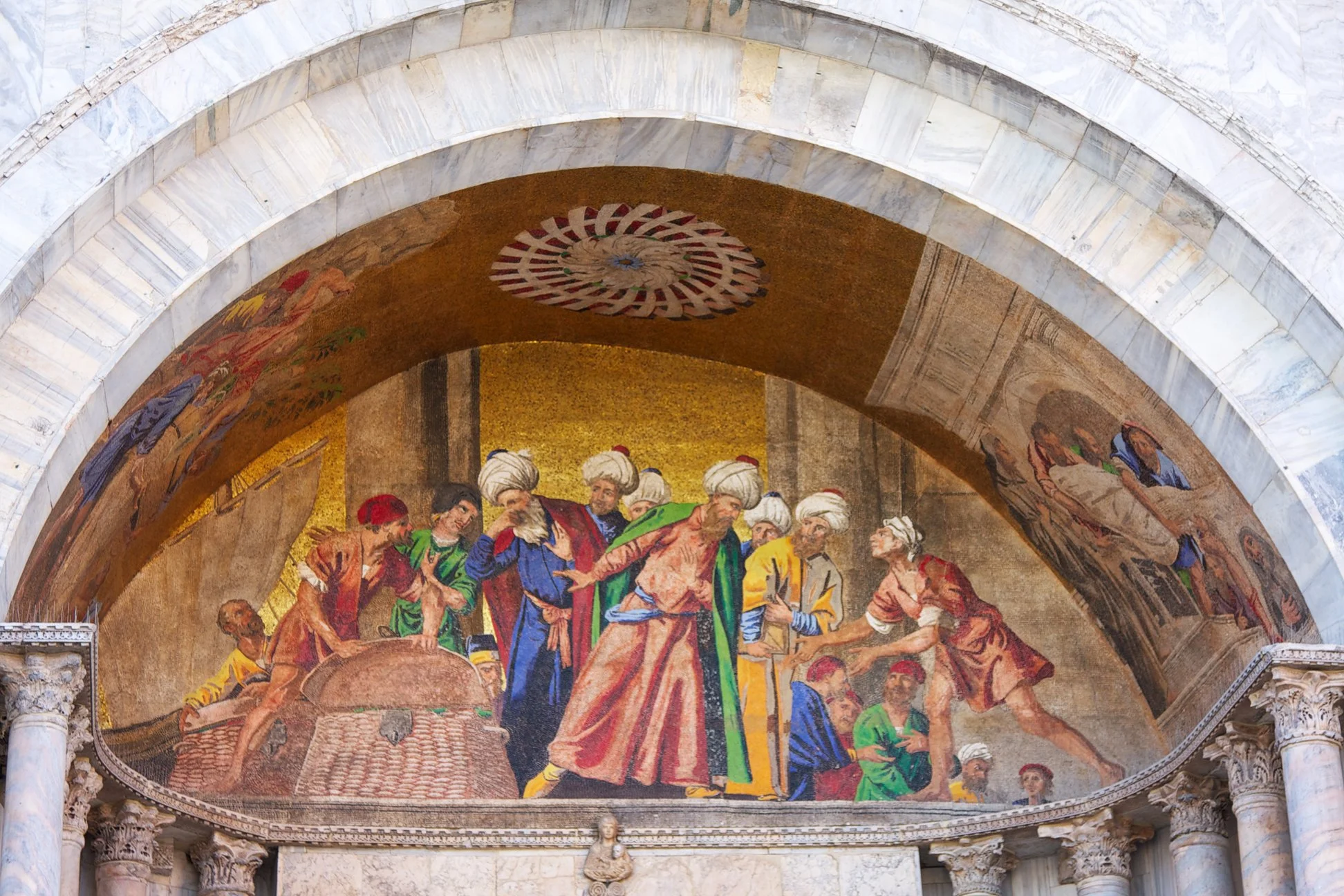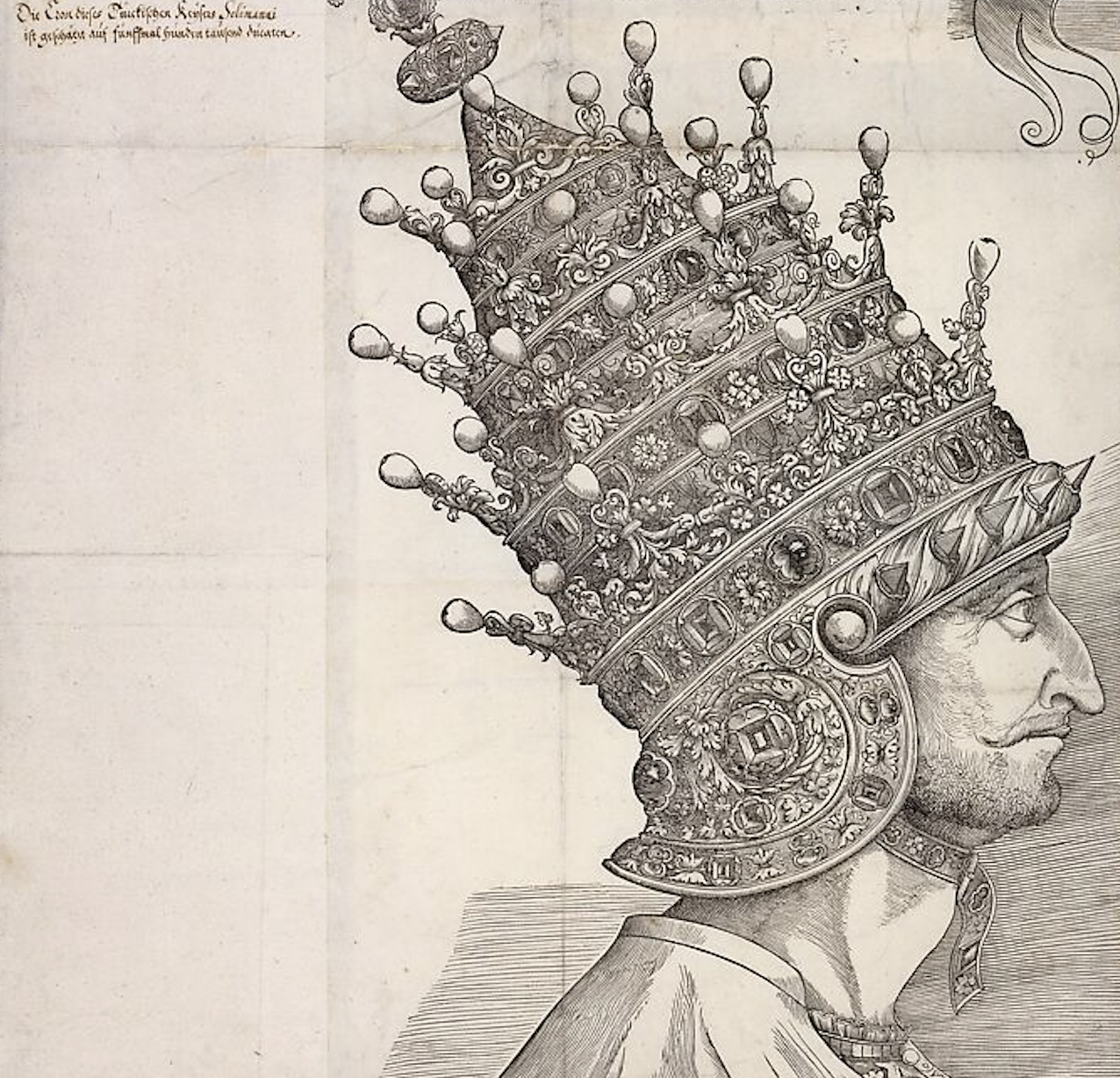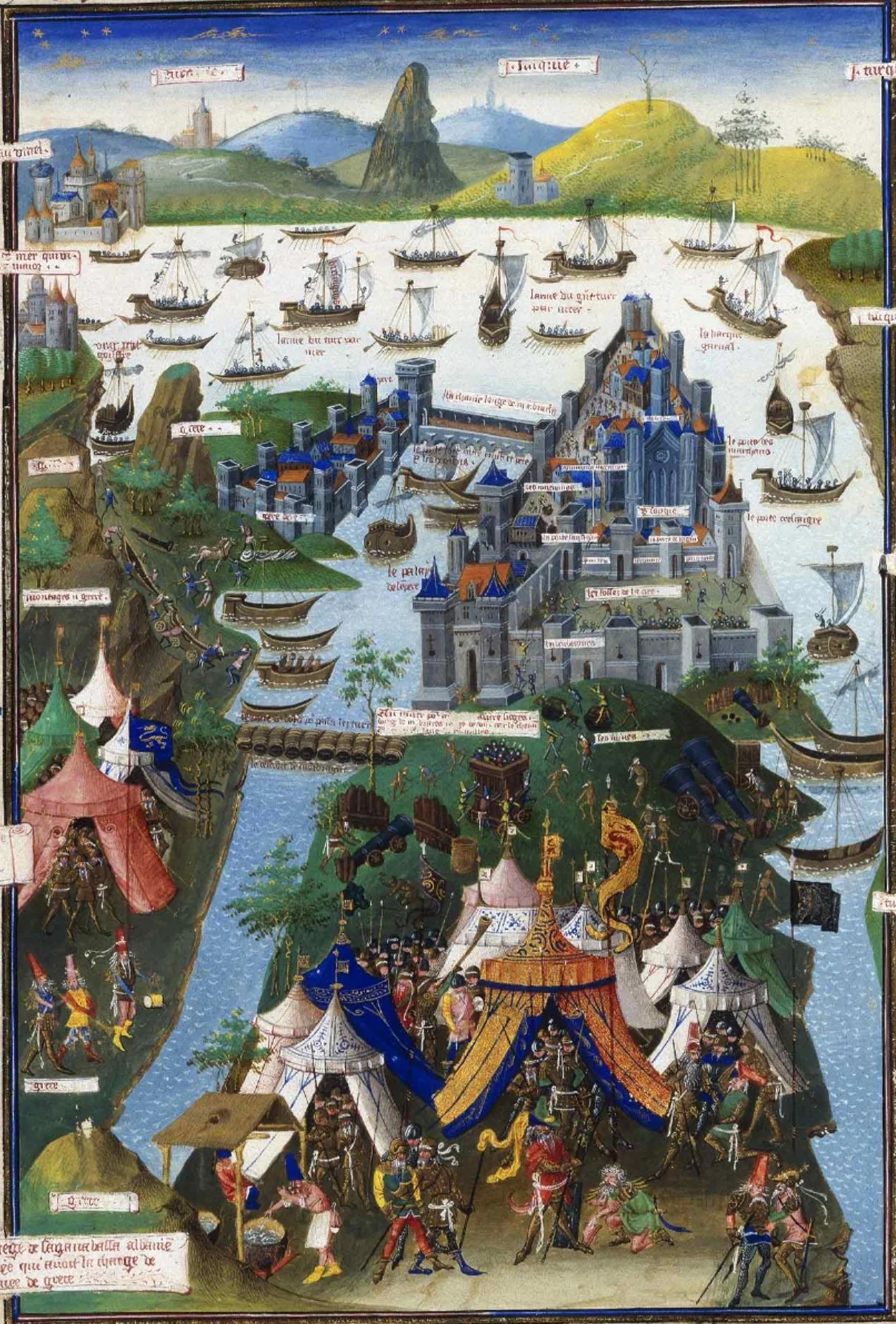Between the Crescent & the Lion
A 16th-Century Journey Through Istanbul and Venice
‘The Custom Officer's’ depicted on the facade of St Mark's Basilica, Venice
While separated by the Adriatic and Aegean seas, Istanbul and Venice were deeply entwined through a shared and turbulent history, particularly during the medieval and early modern periods, when the Ottoman Empire reached the height of its power and Venice strove to maintain its maritime hegemony.
Together, these two cities stood as monumental gatekeepers between East and West, Christianity and Islam, trade and conquest.
Amidst the throngs of merchants, tailors, goldsmiths, lace makers, and other trades within the floating “Carnival of Commerce” that was 16th-century Venice, two renowned goldsmiths — the Caorlini brothers, Luigi and Marco — and Venetian jeweller Vincenzo Levriero had crafted something extraordinary. News spread from Venice’s lagoons, reaching all the way to the Golden Horn and the Ottoman capital straddling it, Constantinople, now Istanbul. The piece, reminiscent of the Papal Tiara created a few centuries earlier, was made of solid gold and formed a multi-tiered, helmet-like crown. Forged in the jewellers’ quarter of the Rialto, it now sat in the Ducal Palace, displayed in its velvet-lined ebony case, in all its flamboyant ostentatious glory.
Sultan Suleyman the Magnificent Wearing the Jewel-Studded Helmet - Anonymous, Venetian, 16th century Italian ca. 1540–50
This magnificent headpiece had not been commissioned; rather, it was a crown made ‘on spec’ for a monarch. Conceived out of wildly audacious imagination, it consisted of four graded hoops or rings, seemingly fastened together with pearl studs along the base of each ring. It was then adorned with forty-nine pearls, fifty diamonds, twenty-seven emeralds, and centred with a large turquoise stone. Atop the helmet was a plumed aigrette with a crescent-shaped mount, all secured by a neck guard strapped to ensure the towering accessory stayed on the fortunate, albeit somewhat poorer, monarch’s head. Within days of its completion, the Ottoman Grand Vizier, Ibrahim Pasha, and the Chief treasurer, Iskender Celebi, were sufficiently impressed and spared no expense in having the headpiece transported over land accompanied by an armed escort to Constantinople where, upon final inspection, it would be presented for the pleasure of its Sultan, Ḳanuni Sulṭan Süleyman “The Lawgiver”, also known as Suleiman the Magnificent.
But East and West were not cultural strangers - Venice and the Islamic world had been connected for centuries by a shared mercantile drive that transcended beyond religion and language. Venice served as the stronghold of Christendom, a crucial part of the route that Marco Polo followed, linking Venice to the great Silk Road, a network of global connections and cultural exchange among kingdoms. The relationship between the two cities was a complex mix of competition, cooperation and coexistence, with the language of power gradually shifting from force to trade, as expansion and dominance went hand in hand with cultural exchange, diplomacy, and commerce.
Marco Polo leaving Venice
Constantinople was a city destined to be the centre of the world - the hinge, straddling Asia and Europe, a city shaped by layers of empire. First known as Byzantium, it was established by Greek settlers in the 7th century BCE and later became Constantinople, the eastern capital of the Roman Empire and subsequently the capital of the Byzantine Empire, under Emperor Constantine. While Western Europe experienced fragmentation, Constantinople endured, preserving Roman governance, Orthodox Christianity, and classical knowledge. Across the Mediterranean, Venice, formed by refugees fleeing barbarian invasions during the 5th century CE, was gradually developing into a commercial hub through trading with the Byzantine East.
By the 11th century, Venice’s strategic position had enabled it to grow into a maritime power with its own ambitions, becoming a leading medieval urban centre in Europe, even as the Western Roman Empire faced significant political, economic, and demographic upheavals. During this time, Venice was nominally a vassal of Byzantium, flourishing under imperial protection and enjoying commercial privileges—granted in charters like that of 992 CE, which opened Constantinople to Venetian traders. The 13th century was a pivotal period in Venice's relationship with the Byzantine Empire, especially after the sacking of Constantinople during the Fourth Crusade in 1204. Venice’s Doge, Enrico Dandolo, saw this as a chance to gain economic and territorial advantages and to boost Venice’s influence in the Eastern Mediterranean, especially as the Byzantine Empire weakened.
Emperor Justinian with his retinue (left) and Empress Theodora with attendants (right). Mosaics from the Basilica of San Vitale, Ravenna,
Originally, the crusade aimed to recapture Jerusalem from Muslims but was diverted due to political, financial, and strategic reasons, with Venice influencing the shift of focus to Constantinople. As the city weakened, Venetians benefited most, claiming key territories and establishing a protectorate over much of the former Byzantine lands. The sack of Constantinople, which included looting relics, art, and treasures, caused lasting resentment among the Greeks, deepening the cultural and political divide between the Latin West and Byzantine East. This event was a turning point, cementing Venetian dominance in the Mediterranean.
By the 15th century, Constantinople had fallen into decline, isolated and lacking significant Western aid despite desperate appeals to Christendom. Meanwhile, a new threat was rising to its east: the Ottoman Empire, which sought not only to conquer Constantinople but also to unite its European and Asian territories, control crucial trade routes between the Black Sea and the Mediterranean, and to claim the prestige of ruling the city that once was the core of the Eastern Roman Empire. Leading this effort was the young Sultan Mehmed, only 20 years old, but a brilliant strategist who gathered an extraordinary army, ships, and massive cannons, including those capable of breaching Constantinople’s renowned Theodosian Walls. The capture of Constantinople in 1453 ended the thousand-year-old Byzantine Empire and significantly shifted power in the Mediterranean, impacting Venice which by the 15th century was at the height of its power. Known as “La Serenissima”, the city now ruled an empire stretching from the Dalmatian coast to Crete, with its merchant fleets dominating Mediterranean trade. Venice’s prosperity hinged on access to eastern markets, and the rise of the Ottomans was both a catastrophe and an opportunity: the Ottomans were now the gatekeepers of the trade Venice could not live without.
The siege of Constantinople (1453), French miniature by Jean Le Tavernier after 1455.
The Ottoman-Venetian Wars that followed for the next decade marked a prolonged struggle for dominance in the eastern Mediterranean as the rising Ottoman Empire clashed with Venice’s influential maritime republic. Venice, allied with Hungary and other Christian nations, sought to halt Ottoman expansion into the Balkans and Greece, while the Sultan advanced both on land and at sea. Fierce sieges and naval battles ensued, including Ottoman assaults on Venetian strongholds in the Peloponnese and along the Dalmatian coast. Despite some Venetian naval victories, the republic struggled to defend its distant possessions against the Ottomans’ greater resources and manpower. The conflict ultimately concluded in 1479 with a treaty that compelled Venice to relinquish key territories. This outcome marked a significant shift: the Ottomans had become the dominant power in the eastern Mediterranean, while Venice, still wealthy and formidable, entered a new phase of defensive diplomacy, increasingly relying on commercial concessions to safeguard its maritime empire.
By the 16th century, however, pragmatism prevailed - both cities recognising that trade and prosperity were far preferable to disruption and conflict, fostering a peaceful coexistence that reinforced Venice’s role as a buffer between East and West, as well as Istanbul’s pivotal position. As one Venetian ambassador noted, "being merchants, we cannot live without them." Between the two cities flowed commodities such as wheat, spices, raw silk, cotton, and glass-making ash, along with luxury items such as soap, paper, fine textiles, carpets, inlaid metalwork, and illustrated manuscripts. This period also witnessed the age of diplomacy: a time when the concept of “otherness” diminished, facilitating a fusion of East and West, and a shared exchange of ideas, arts, and crafts, as well as mutual understanding and recognition. The courts of Venice and Istanbul welcomed representatives from their counterparts - the arrival of Ottoman ambassadors was treated as a grand waterborne spectacle, an ornate ceremonial reception on gondolas and state barges gliding along the canals, formally greeted by Venetian officials at the docks. These envoys, clothed in richly embroidered attire and often accompanied by exotic retinues, were presented with the same if not greater ceremonial honour as other Christian envoys.Venice's representatives in Constantinople, which included ambassadors and a bailo, lived in style for two to three years at a time, managing an embassy and promoting Venetian-Ottoman trade. The Venetian embassies recorded the lavish feasts they enjoyed at the Ottoman court, where bountiful food from all corners of the vast empire was prepared by skilled chefs, with Venetian diplomats presenting sultans with gifts of astronomically expensive parmesan cheese.
View of a bazaar in Constantinople. Miniature taken from a 19th century Cicogna manuscript (1828) after an original from the 17th century (1671). Venice, Biblioteca Marciana
A notable bailo was Andrea Gritti, who served as a merchant and Venetian envoy in Istanbul before being elected Doge in 1523. Gritti built a network of personal connections with important Ottoman figures, including Grand Vizier Ibrahim Pasha, who helped foster a cooperative diplomatic environment, especially with the new Sultan, Suleiman the Magnificent. Suleiman maintained a cordial and pragmatic relationship with Gritti and Venice, valuing their commercial interests and Gritti’s relationships with Ottoman officials, which contributed to stable diplomacy. Gift-giving was a key part of diplomatic exchanges, with the Venetians and Ottomans exchanging luxurious gifts like carpets, clocks, glassware, gourmet foods, metalwork, musical instruments, perfumes, and silk robes. The spice trade was a key part of Venice's economy, connecting the two cities. Venetian merchants travelled to eastern ports including Alexandria, Beirut and Constantinople to acquire spices, foodstuffs, incense, and perfume, later selling them to European merchants in local markets. Spices such as pepper, cloves and cinnamon came from India via Ottoman-controlled Egypt and Syria. Such was the dominance of Venice and the Ottomans in the spice trade that Portuguese sailors were spurred to circumnavigate Africa to reach Asia.
Textiles also played a central role in trade between the two cities, with the most impressive items being brocaded silks and velvets—rich fabrics with raised patterns created with gold and silver threads. Silk represented status, and the elite used it for clothing, furnishings, and rituals. Venice had become internationally renowned for its silk production by the 15th century, and Ottoman sultans famously favoured kaftans made from their silks. Owning Ottoman objects in Venice also signified social status, especially among the noble and wealthy merchant families lining the canals of the Serenissima. These households displayed and utilised Islamic decorative pieces such as carpets, İznikware, and round-bottomed metal bowls in their dining rooms, and they imported incense and bronze pomanders to scent their homes. Meanwhile, in Istanbul's Grand Bazaar, Venetian Murano glass was readily available, and Ottoman spices and coffee were highly prized in Venetian markets.
Second half of the 16th century - Silk, metal-wrapped thread; cut and voided velvet, brocaded. From the Metropolitan Museum of Art, New York
Even their cuisines shared some similarities, too. Risotto for instance, a beloved staple of Italian cuisine, was most likely inspired by Ottoman pilaf, and Ottoman rice pudding and sherbet desserts gained popularity in Venice - the former, known as riso turchesco or Turkish rice, made with rice, butter, cinnamon, milk, rosewater and sugar.
But the 16th century also saw a series of military clashes between the two powers, each drawn into the global politics of the age, as Istanbul’s rapidly expanding Ottoman fleet—built in the imperial arsenal at Galata and commanded by renowned admirals like Hayreddin Barbarossa—directly contested Venice’s powerful armadas from the Arsenal of Venice, leading to decisive clashes over control of the Aegean, Ionian, and eastern Mediterranean seas. In the 1530’s Suleiman the Magnificent allied with Francis I of France against the Habsburgs, forcing Venice into a delicate balancing act. The Ottomans laid siege to Venetian fortresses in the Aegean, culminating in the Treaty of Constantinople in 1540, in which Venice ceded additional territories but retained its trade privileges. However, the wars also established a new diplomatic norm. Despite the skirmishes, both powers recognised the futility of prolonged conflict. Peace was never permanent, but treaties introduced periods of relative stability that enabled economic and cultural exchanges to thrive throughout the centuries, despite the presence of war and peace, as both powers sought to preserve their waning influence in an ever-changing Mediterranean world.
Piazzetta San Marco and Colonna di San Marco in Venice
Walking through Venice today, it's impossible not to notice Istanbul’s influence. Byzantine and Islamic cultural elements are evident in the domes of St. Mark’s Basilica, the detailed arabesques of its decorations as Venice deliberately modelled itself as a “second Constantinople,” integrating its relics, art, and architecture. Conversely, in Istanbul, the Topkapı Palace—mainly in an Ottoman-style—also demonstrates the empire’s engagement with European design. Venetian paintings, textiles, and glassware, highly prized at the palace, still decorate the halls of the harem and the sultan's private chambers. Visitors often marvel at these sights, which also reveal a deep, interconnected history. Venice's Arsenal hints at maritime battles against Ottoman fleets; the Süleymaniye Mosque symbolises the power of a sultan who viewed Venice as both rival and ally.
But the artefact I feel best exemplifies the complex pragmatism of these two cities and powers is the magnificent Venetian crown helmet crafted in the jewellers’ quarter of the Rialto, transported to Constantinople, and worn by Suleiman the Magnificent at Vienna's gates in 1532, during his attempt to seize a key part of the German Habsburg empire. To me, it represents a story of two interconnected cities, a Christian maritime republic and an Islamic empire, linked not by faith, but by trade, diplomacy, and shared history in the Mediterranean, where power, culture, and commerce were deeply intertwined.
View of the Suleymaniye Mosque, Istanbul
ISTANBUL TO VENICE
The Gates of East & West
On this 16-day tour with Dr Lauren Mackay, explore the two great medieval cities of Istanbul and Venice, indissolubly linked through their shared history and culture.








